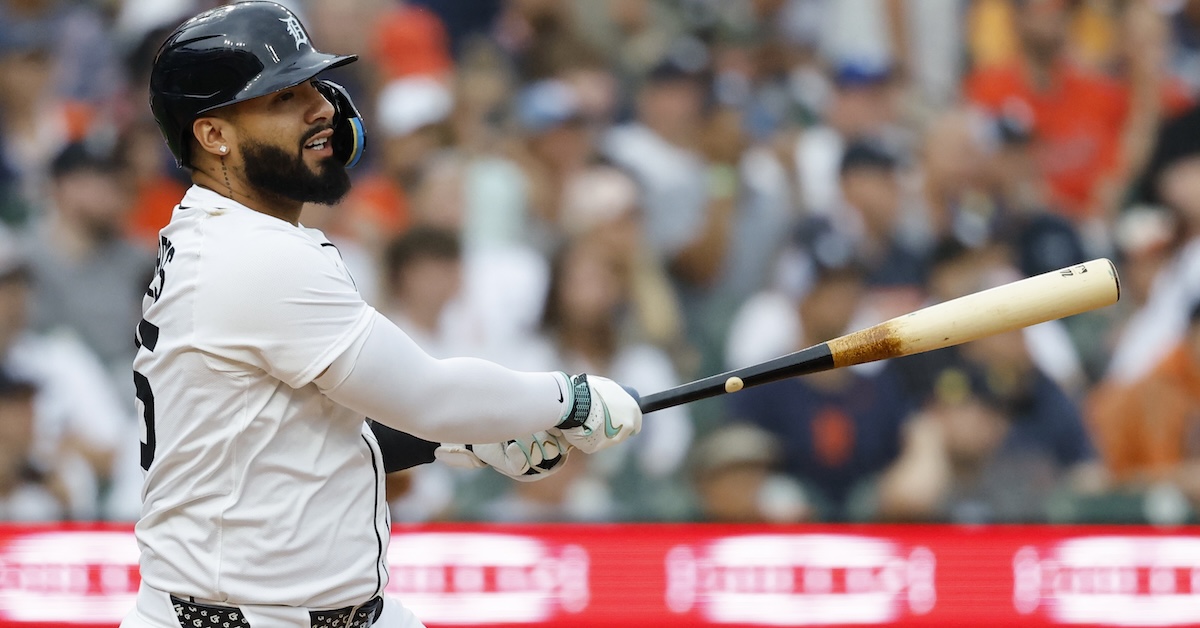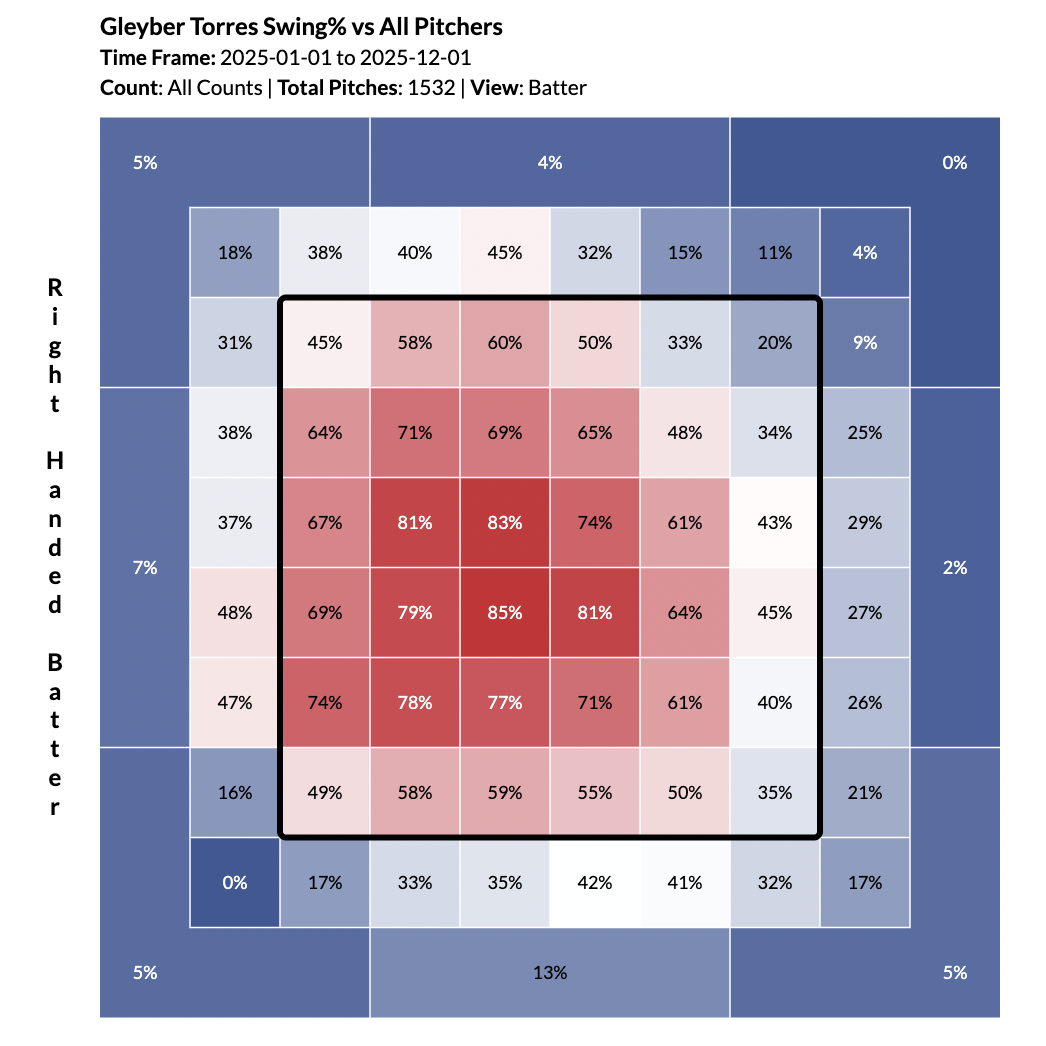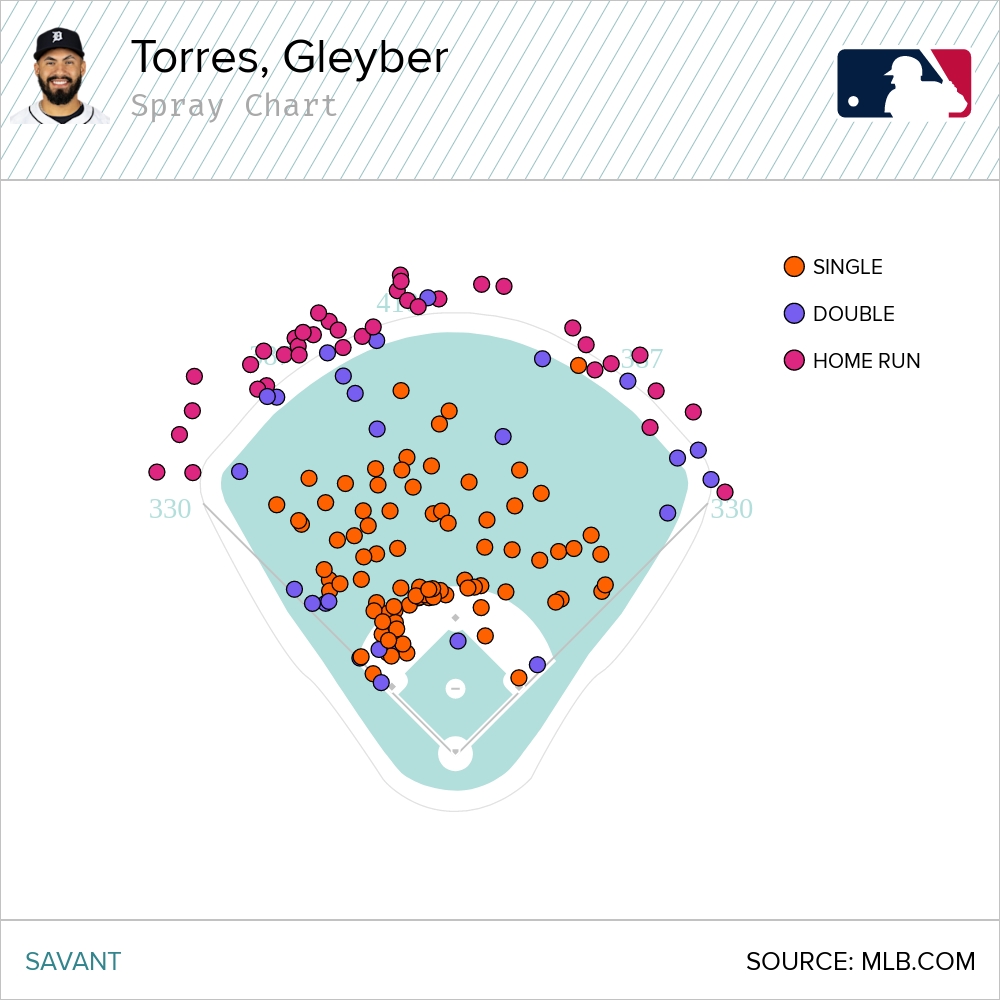Gleyber Torres Is So Annoying

In the final days before the All-Star break, the Mariners threw 60 pitches to Gleyber Torres. I swear he didn’t make a single incorrect swing decision.
Fastball jammed inside on a 2-2 count? He’ll spoil it.
Slider dropped in the chase zone, low and away? Easy take.
Fastball pinned to the top edge in a full count? That’s a walk.
What’s a pitcher to do? Torres went 5-for-10 in the series with two doubles and two walks. It wasn’t the flashiest series, and it’s not really the flashiest batting line. He’s hitting .282/.390/.421 this year, which scans to me more as “very good” than “great.” But if there were an award for “most annoying at-bat,” I’d submit a nomination for Torres.
When I think of annoying hitters, I don’t necessarily think of guys like Aaron Judge, Shohei Ohtani, and Cal Raleigh. They are certainly the best hitters, but they also have a clear weak spot, some combination of location and pitch type where pitchers can beat them. Judge, for example, whiffs 80% of the time when faced with a four-seam fastball at the top rail. (He also sees these types of pitches less frequently than nearly any other hitter, which is perhaps the subject of another post. Pitchers don’t have that much practice throwing heaters four feet above the plate for strikes.)
These premium power hitters exact the most damage in the aggregate. But on a plate appearance-by-plate appearance level, there are a decent chunk of encounters where they leave with a zero.
Torres, on the other hand, doesn’t appear to have any clear weakness. If a right-handed slider is thrown to the lower rung of the strike zone, Torres might roll over it. Otherwise, I’m not exactly sure how a pitcher would go about designing a plan of attack. He crushes high pitches and lets anything just above the strike zone sail by. He spits on pitches just below the zone, takes the ones off the corners with ease, and spoils anything close with two strikes. And throw a pitch over the middle and he’s always ready to attack.

Torres walks more than he strikes out, one of only four hitters in the league that can make such a claim. Only Juan Soto chases less often. Using the very simple swing decision measurement of z-swing (zone swing) minus o-swing (outside the zone swing), Torres ranks 11th among the 253 hitters with at least 200 plate appearances as of the start of play Monday.
It ought to be no surprise, then, that the more sophisticated swing decision metrics perceive Torres as among the very best in the sport. In 2023, Robert Orr of Baseball Prospectus created a metric called SEAGER, which grades the value of each swing decision. Torres currently sits in the 99th percentile of SEAGER, accompanied by a select few hitters, including Corey Seager himself.
Torres wasn’t always this kind of hitter. Yankee fans will never forget his age-22 season in 2019, when he bashed 38 home runs, posted a .337 OBP, and set unreasonably high expectations.
At that early stage of his career, Torres was selling out for power. His pull fly ball rate was in the 74th percentile of hitters; many of his batted balls were elevated to left and left-center field.

Chasing power came with trade-offs — his zone contact and chase rates were well below the league average, leading to a below-average walk rate. But that season was by far his most prolific, even after factoring in the juiced ball.
Whether it was his bat slowing down, changes to the ball, injuries, or some unfortunate combination of all three factors, Torres never again touched that 2019 production. The COVID season could be written off, but the nine homers across the 2021 campaign raised red flags. At the time, Devan Fink examined Torres’s woes in a post titled “Gleyber Torres Should Be Hitting for More Power Than This.” In the piece, Devan noted that Torres had lost his ability to pull fly balls in the air, finding himself late on fastballs at the top of the zone.
In 2025, Torres is turning that weakness into a strength. He no longer needs to lift the ball into the left field bleachers. Instead, he’s waiting on pitches and pushing them up the middle or the opposite way.
There were signs that he was embracing this approach last year. His chase rate leaped up from the 70th percentile in 2023 all the way to the 92nd percentile in 2024. He scooted back in the box about an inch; his average intercept point at contact shifted from two inches in front of the plate to two inches behind it.
However, he just wasn’t impacting the ball. By Orr’s damage per batted ball metric and by 90th percentile exit velocity, Torres ranked about one standard deviation below the mean. But 2025 has found Torres shifting to the good side of the bell curve. It’s not like he’s crushing the ball — his EV50 is 60th percentile among qualified hitters — but it’s enough oomph to lift his batting average, especially while putting more balls in play. Meanwhile, he’s taking a bunch more walks — ninth most among qualified hitters — and striking out at nearly half the frequency.
Even with subpar bat speed, Torres is making pitchers’ lives extremely difficult. He’s not doing it like most other highly productive hitters, such as his teammate Riley Greene. He tried that; it was working, and then it stopped working. So he turned himself into a nuisance, slapping singles to right field and setting the table for this Detroit offense that, shockingly, has been among the best in baseball.
A 132 wRC+ and a 4-ish WAR pace is quite a rebound campaign for a guy who, even as one of the youngest players available on the market, had to settle for a one-year contract last offseason. A bad year could have relegated Torres to the Tim Anderson/Joey Gallo class of productive late-2010s hitters fading fast from relevance. Instead, he’s set himself up for a healthy multi-year deal, fueled by the refusal to give opposing pitchers a single inch.
Michael Rosen is a transportation researcher and the author of pitchplots.substack.com. He can be found on Twitter at @bymichaelrosen.

The Tigers need to sign Gleyber Torres to a long-term deal … but they don’t. He’s the perfect guy at the top of the order for them, a veteran who works the count and gets on base. He’s revived Javy Baez. He’s a mentor to a bunch of guys just learning what it takes to win, which makes A.J. Hinch’s job that much easier.
But he’s also going to cost a lot of money on a team that has a number of younger, cheaper alternatives, especially with Kevin McGonigle coming through the pipeline and Keith/Jung/Lee all needing plate appearances, not to mention McKinstry and Vierling. If I’m Scott Harris, I love having options. But Torres is going to make things difficult this offseason.
It seems very likely the Tigers give him a QO, he declines, and the Tigers receive draft pick compensation. I would think both parties would be very happy with this scenario.